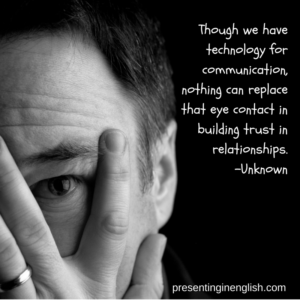
EYE CONTACT: the situation in which two people look at each other’s eyes at the same time. -Cambridge Advanced Learner’s Dictionary
How would you feel if you were having a conversation with someone and they never looked at you directly? You might feel that they were nervous or that they weren’t really interested in talking to you. This is how your audience will feel if you don’t make eye contact with them.
When we talk about eye contact this doesn’t mean staring at members of the audience for a long time nor does it mean injuring your neck because you are looking around so quickly. It means to scan the room slowly and look at different parts of your audience.
Eye contact is important because it helps you connect with your audience. We all have mirror neurons in our brain that help us create an understanding or rapport with another person. These neurons are the foundation for the emotion of empathy. For example, if we are watching someone describe an injury to their arm, we may feel the need to touch our arm. These are the motor neurons at work. The easiest way for the motor neurons to understand what the other person is feeling is through watching their eyes.
For presentations this means if you want the audience to connect with your message you need to be looking at them. You should aim to look at each area of the audience. I like to divide the audience into 9 sections. At a minimum I look at one person in each of those sections. That way I make sure that each part of the audience feels included.
| Front Left | Front Centre | Front Right |
| Middle Left | Middle Centre | Middle Right |
| Back Left | Back Centre | Back Right |
How long should you look at each person? This is a matter of personal preference. Some speakers will look at one person for up to thirty seconds when they are making an important point. A habit you can develop is to look at one person for one sentence. Then at the beginning of a new sentence look at another person. This creates an easy and clear transition.
Do you need to look them directly in the eyes or can you look somewhere else? Eye contact is most effective when you are looking at directly at someone. Last year, a study published in the journal Environment and Behaviour found that participants were more likely to choose a cereal box over its competitors if the characters on cereal boxes were making direct eye contact.
However, there are tricks to get around this if you are particularly nervous. If your audience is far enough away, you can look at a person’s forehead or just above their head and they will still feel like you are looking at them.
